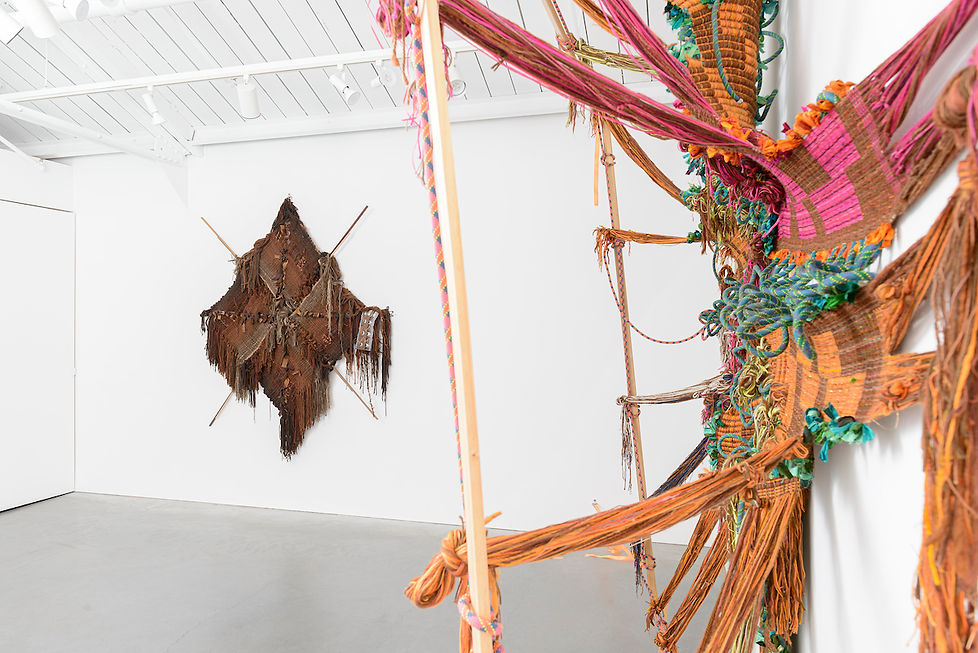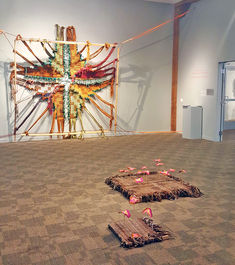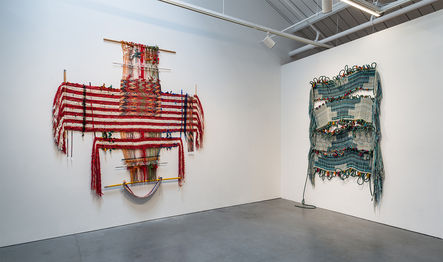Coming Summer 2020!
To Carry Every Name But Your Own
10 September - 22 October 2022, Eleanor Harwood Gallery, SF

Installation View, Photo Credit: Shaun Roberts Photography
Press Release
Eleanor Harwood Gallery is pleased to present Kira Dominguez Hultgren’s third solo exhibition with the gallery.
To Carry Every Name but Your Own is a show woven from wool, silk, sisal, and Kevlar, in pieces of fluff and knots of grief. This show considers the question: What is a woman's body asked to carry?
Dominguez Hultgren grounds this show in the archive of documentation that surrounds Julia “Luz” Jiménez (1897-1965), a Nahua-Mexican artist, model, Nahuatl-language educator, storyteller, and weaver. Much of this documentation consists of paintings, drawings, sculptures, and photographs created by members of the Mexican Modernist school. Artists in the movement included Diego Rivera, Jean Charlot, Fernando Leal, and Tina Modotti.
Jiménez has been called the most painted woman in Mexico. People may not realize that they recognize her from Diego Rivera’s work. In Rivera’s paintings she was depicted holding calla lilies, weaving, or rolling out dough. Her figure was used to depict a quintessential Mexican woman. Art historian John Charlot’s son explains that, for his father, Jiménez was “the woman he saw in all women of Mexico” (Sylvia Orozco, “Luz Jiménez in My World”).
Weaving, holding jars and baskets, and caring for her daughter became the visuals that the artists around Jiménez created and, to an unknown extent, Jiménez curated. She is the woman who carries the nation in her hands, strapped to her back, inside her womb.
And while this show tries to acknowledge the ways Jiménez used the platform these artists gave her – to tell and publish her own stories about the Mexican Revolution, her hometown of Milpa Alta, Nahua culture and identity, and how she worked with ethnographers to translate Náhuatl – this show is also about all that Jiménez as a symbol, as a person, is still asked and made to carry.
Perhaps this tension – using the basket she’s holding and the belt she’s weaving as code-switching devices – is what draws Dominguez Hultgren to Jiménez. In her own weavings, Dominguez Hultgren uses materials spun from the dust hiding in the corners, the hairballs in the shower, the clothes from her grandmothers’ closets, and rope from her favorite climbing gyms. She builds looms that become the scaffolding to hold up the stories that one generation had to forget and another generation had to remember; multi-plied generations weaving into one another.
For more images and information, please see Eleanor Harwood Gallery's online viewing room
Installation Views "To Carry Every Name But Your Own," Eleanor Harwood Gallery. Photo Credit: Shaun Roberts Photography
Kira Dominguez Hultgren: Luz Jiménez
March 17 - April 23, 2022, Heroes Gallery, NYC

Installation View, Image courtesy of Heroes Gallery
Press Release
Heroes Gallery is pleased to present works by contemporary artist Kira Dominguez Hultgren in conversation with the history of Nahua-Mexican artist, model, Nahuatl-language educator, storyteller and weaver Julia “Luz” Jiménez (1897-1965). By engaging with documentation and artwork about Jiménez’s life and the influence she had on the Mexican Modernist School, Dominguez Hultgren weaves an accumulation of cultural narratives and intertwined identities. How is weaving used to authenticate identity both in Jiménez’s life and in Dominguez Hultgren’s?
Self-described Chicanx, Indian and Hollywood Hawaiian, Dominguez Hultgren sees her ancestry mirrored in her weaving; an embodiment and performance of strange combinations. She weaves in the tension between performing and preserving cultural identity and finding one’s self within the romanticized ideal of the indigenous woman at her loom.
Dominguez Hultgren states that “in (my) weavings nothing gets blurred; rather the vertical and horizontal materials move in opposite directions, each strand holding its own in-between warp and weft. To weave with competing, unequal materials is to reflect a lived experience of colonialism supported by unequal histories where some stories go unheard, unseen, while others seemingly become the whole story.” Weaving becomes a metaphor in which the intertwining of material represents different truths, personas and perceptions.
What is seen and unseen interlace to create identity. To perform or preserve an identity is not a choice between falsifying and truth-telling, but a strategy to make sense of one’s story in a larger web of non-neutral tensions and histories.
Luz Jiménez lived this tension in her time, using the platforms given to her, using her audience’s perceptions of her, to tie her story and her people to the larger history of the Mexican Revolution and modern art. For members of the Mexican Modernist school such as Diego Rivera, Jean Charlot, Fernando Leal and Tina Modotti, she became a symbol of idealized Mexican identity and the perfect artist-model for their work. Jean Charlot ‘s son and art historian John Charlot explains that for his father, Jiménez was “the woman he saw in all women of Mexico” (Sylvia Orozco, “Luz Jiménez in My World,” 149). Jiménez used this platform to talk about Nahua identity and culture, translate Náhuatl with ethnographers, tell and publish stories of her hometown Milpa Alta before and after the revolution. In other words, Jiménez wasn’t only Mexican; she was also Nahua. She moved though, worked in, and knew the language of many worlds.
For more information about Luz Jiménez, please visit Heroes Gallery's website. Heroes Gallery would like to acknowledge Jiménez’s grandson, Jesús Villanueva Hernández, who works to gather a family archive and dedicates himself to his grandmother’s legacy.
Reviewed by Will Heinrich, New York Times, April 15, 2022: "No single knot or stretcher bar stands out more than any other, but they don’t quite blend together, either. Instead, the impression made, say, by “Colita de Rana” is less like a singular picture than like a complex spiritual machine."
Installation Views courtesy of Heroes Gallery
Make Room
May , 2021 - August 14, 2021, NADA House Governors Island, NYC

Press Release
Eleanor Harwood Gallery at NADA House on Governors Island opens a solo presentation by Kira Dominguez Hultgren.
From Dutch windmills to fans that replace the air in the Hugh L. Carey Tunnel every ninety seconds, Governors Island evinces the histories of revolving (pun intended) technologies and people groups. In "Make Room", artist Kira Dominguez Hultgren will explore through three large-scale sculptural weavings and a cacophony of woven materials, how technical and social revolutions both displace and assimilate that which, and those who, came before. Is it a circular narrative, a traceable line, or is it the uncanny present absence of something more, someone else that both situates and dislodges the maker and viewer in the exhibition space?
Reviewed by Roberta Smith, New York Times, May 6, 2021: "Textiles speak loudest here. Kira Dominguez Hultgren (Eleanor Harwood Gallery) has nearly overwhelmed one room with riveting textiles. The monumental No Dogs Allowed, a fan-shaped structure of cord and thread nominates this artist as the heir to Sheila Hicks."
Make Room, Installation Views
New Art Dealers Alliance
NADA House 2021
June 16, 2021, 4pm
Artist Talk with Kira Dominguez Hultgren
On Zoom
I was India: Embroidering Exoticism
March 4, 2020 - September 12, 2021, San Jose Museum of Quilt and Textile

Press Release
San Jose Museum of Quilts & Textiles (SJMQT) is pleased to announce a new exhibition opening on March 4, 2020: I was India: Embroidering Exoticism, a solo exhibition by Kira Dominguez Hultgren.
Bay Area-based artist Kira Dominguez Hultgren explores what it takes to make an Indian. Her work incorporates cultural and familial materials, as she opens up her grandmother’s cedar chest to reveal two Punjabi phulkaris embroidered by her auntie Dalip Kaur around 1925. Phulkaris, or saloos as her family calls them, are commonly seen as head-coverings and shawls that typify the material cultural practices of pre-partition Punjab. In this exhibition, they become the process or treasure map by which themes of colonial and contemporary exoticism, handwork, and the spectacle are surveyed. Through woven sculpture and installation, Dominguez Hultgren invites visitors to step with her into phulkari practice as a transgressive process that challenges both personal identity and global histories.
We are excited to share this exhibition, already hailed as one of KQED’s “Six Bay Area Art Shows to See in 2020,” with our visitors this March.
I was India: Embroidering Exoticism, Installation Views
Updated Press Release from SJMQT
When the Museum closed due to shelter-in-place orders in March, Kira's solo exhibition, I Was India: Embroidering Exoticism, was the first ever in our history to be converted into a virtual format. Watch an introduction from virtual exhibition co-curator and SJMQT intern Shilpa Shah.
Intrusions
January 11th - February 29th, 2020, Eleanor Harwood Gallery, SF

Installation View, Image Courtesy of Shaun Roberts Photography
Press Release
January 11th, 2020 (San Francisco, CA) — Eleanor Harwood Gallery is pleased to present Intrusions, our second solo exhibition with Kira Dominguez Hultgren.
Kira Dominguez Hultgren weaves together histories of tangled intrusions nourished on the global confusion of the word Indian. Beginning with two Navajo weavings (artists unknown) from around 1876 and two Punjabi head-coverings embroidered by her great-aunt Dalip Kaur around 1923, Dominguez Hultgren mines with material hyperbole (hyperbolic tension on gallery-sized looms) the historical narratives that surround these two “Indian” archives. Indian, in this context, becomes synonymous with exoticism, with Edward Said’s orientalism, a theory which understands Indian to be a binary opposition to American or British, a term by which the Euro-American colonizer understands their own self and nationhood as, “that which the Indian is not.”
What does it mean to form an identity or nation in the negative, in distinction to what one is not? This is the question which motivates Dominguez Hultgren to weave through photographic documentation of two Navajo weavings from around 1876 in her work, “In the Negative.” These weavings were used as symbols of U.S. patriotism in exhibition catalogues, and centennial and bicentennial celebrations across the U.S., since the visual imagery in the weavings are a U.S. flag and the number 100. Yet, through her research at the Palace of the Governors Photo Archive (Santa Fe, New Mexico), Dominguez Hultgren follows what she believes to be intruding counter-narratives structurally embedded into these Navajo weavings. While the U.S. may have been forming a national identity through “Indian” weaving, Dominguez Hultgren sees an artist intentionally weaving nearly invisible zigzag lines that not only cut perpendicular to the horizontal red-and-white stripes of the flag, but leave the flag structurally vulnerable, quite literally in tatters, even if visibly whole. Rather than submitting to a binary distinction of Indian versus American, colonizer versus colonized, Dominguez Hultgren sees this artist as transmuting binary red and white stripes, vertical warp and horizontal weft lines into a slantwise deconstruction of the flag. The viewer must turn their gaze to read this flag, to read this historical narrative, at varying 45 degree angles, an angle which in fabric terminology is known as “the bias.” Perhaps rather than a symbol of nation, this Navajo weaver gives us in our own flag, a study of biases, a study of prejudice, in which one people group is defined at the expense of another.
In this show, Dominguez Hultgren also transmutes vertical and horizontal lines slantwise, turning crosses into Xs, following and cutting into the personal and historical biases by which not only these Navajo textiles are understood, but also two Punjabi head-coverings embroidered by her great-aunt and passed down to her from her grandmother. These embroidered head-coverings or shawls are called phulkaris, meaning flower-work, since the entire cloth is often covered in geometric-shaped flower embroidery. This art form comes from pre-partition Punjab, a region which stretches across the border of what is today Pakistan and India. Like this region, phulkari embroidery is also partitioned, broken up into many parts that look like a uniform whole. Motifs that at first glance appear to be one single floral design morph into and out of one another, changing, dropping off, disappearing mid-stitch. Although Gandhi used the handspun cloth upon which this embroidery was done as a symbol of Indian self-sufficiency and revolution against the British empire (this cloth was known as khadi cloth) – phulkari embroidery intrudes into Gandhi’s narrative for India, burying it in colorful orange and pink silk, imported from China. Within this historical setting, phulkari embroidery begs the question: Where is the Indian in this work? Is India buried in the cloth, or once exported to America, does phulkari no longer speak to Punjabi partitions and an artist’s personal design decisions, but instead become a symbol for India as a whole nation, an entire culture, a sub-continent? Through her works “Arose” and “X on the Horizon,” Dominguez Hultgren, herself a Punjabi export to America, considers what it means to be Indian and to live in diaspora, (dis)placed like the stitches of her great-aunt’s phulkari in straight and biased lines.
For Dominguez Hultgren, textiles are an archive of material metaphor and physical protest from which she can reenact and destabilize historical narratives. Through both these two Navajo weavings and two Punjabi phulkaris, Dominguez Hultgren questions how woven intrusions are both a lens by which to see the intersections of nation, culture, history, and technology as they intrude into and form the brown body, the Indian, as well as manifestos, instructions by which she can flip those same intersections back on themselves. In her work, “Made in Mexico; XicanX and the Second(Hand)-Generation,” Dominguez Hultgren conflates the Indian within her own identity, finding that to be both colonized and colonizer on two different continents (Asia and North America), a daughter of an immigrant and migrant, leaves her decidedly biased, moving at cross-purposes to both. Or as Indigenous scholars Malea Powell and Gerald Vizenor describe, to be Indian is to leave the representation in ruins.
Intrusions, Installation Views, Images Courtesy of Shaun Roberts Photography
UNTITLED, ART
January 16 - 20, 2020, Facebook, SF

Installation View, Image Courtesy of Phillip Maisel Photography
Wall Text
Through her weaving practice, artist Kira Dominguez Hultgren explores how the act of art-making can foster empathetic connections. She conceived her large-scale textile installation, Cosmic Fluff, as a response to social media’s role in the so-called “loneliness epidemic.”
Dominguez Hultgren defines the concept of empathy using the original Greek term “in-pathos,” meaning “feeling through something together.” For Cosmic Fluff, Dominguez Hultgren started with one massive piece of “fluff,” a raw sheep fleece, which she pulled apart, spun, and wove together in a process that acts as a metaphor for tangible, authentic, in-real-life connections. The artist suggests that, by working within a space of raw, honest emotion, possibilities for mutual understanding emerge.
Wall Text (part 2)
Become the Loom! Participatory Weaving
Together, we'll feel our way through material that expresses contemporary metaphors: (inter)nets, webs, attachments, and digital community. What happens when these intangible expressions are made tangible, in tension between our bodies? Do we feel vulnerable, held, integrated, a part in a machine, or something else? Is this just a fun anachronistic exercise of out-dated tech known as backstrap weaving? Come strap yourself in and play for a minute or ten in this bit of Cosmic Fluff.
UNTITLED, ART Facebook Booth, Installation Views, Images Courtesy of Phillip Maisel Photography, CCA Communications, and Lakshmi Johal-Dominguez
Wingspan
May 5th - June 23rd, 2018, Eleanor Harwood Gallery, SF

Installation View, Image Courtesy of Shaun Roberts Photography
Press Release
May 5th, 2018 (San Francisco, CA) — Eleanor Harwood Gallery is pleased to present “Wingspan” our first solo show with Kira Dominguez Hultgren.
In Wingspan, Dominguez Hultgren considers not just what is within reach, but how bodies can move beyond the limits that are imposed on them. Much of the research for Wingspan began in the Smithsonian’s digital anthropological archives of Navajo textiles. There, Dominguez Hultgren encountered the story of Navajo weaver Juanita (Asdzáá Tl’ógí) from the 1870s and her weaving of a U.S. flag. “Juanita’s weaving is written about as though it’s just a symbol of treaty and assimilation,” Dominguez Hultgren says. “But there’s more going on than capitulation to a sign of U.S. nation.” In Wingspan the artist explores through her own weavings what “more” might start to look like.
Kira Dominguez Hultgren weaves past the edges of the fabric, if her woven mixed media sculptures can even be called fabric. Materials and color refuse to stay fixed in place, preferring instead to exist in a tension that twists and compromises the weaving. Through the exuberance of woven material, Wingspan explores that which makes and pulls apart the fabric of identity: race, nation, color, technology, and cultural categorizations writ large. It is in the margins, in the fringe of the weavings, where new possibilities open up for the artist.
As she weaves she plays and wrestles in this generative tension of materials pushing up, adding on, changing, and being changed by one another. Sometimes the pieces include recognizable symbols, images, or letters. But what begins as a U.S. flag, an Aztec eagle, images of Navajo or Punjabi fabric, or even digital seriality, become unrecognizable in the collision of competing material, color, and personal history that pile into and create and obscure the symbol.
Handspun wool meets plastic tubing. Aluminum thread winds onto industrial felt. The Aztec eagle gets woven in Indian sari silk split apart by used Berkeley Ironworks climbing gym ropes. Yet there’s still more to the story of identity and culture than these materials can possibly show. To weave past the edges, into and beyond the fringe, means that in Wingspan, the weaving is never finished.
Wingspan, Installation Views, Images Courtesy of Shaun Roberts Photography


















































